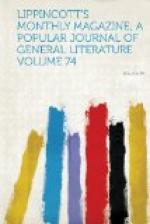The Bishop Hill Community, in Henry county, Illinois, was formed by a party of Swedes who came to this country in 1846 under Eric Janson, who had been their religious leader in the Old World, where they were greatly persecuted on account of their peculiar religious views. They suffered great hardships in effecting a first settlement, some of them going off, in the interest of the community, to dig gold in California, and others taking to stock-raising and speculating. In this they were quite successful, so that jobs and speculations became the peculiar work of this community. They took various public and private contracts; among others, one to grade a large portion of the Chicago, Burlington and Quincy Railroad and to build some of its bridges. In 1859 they owned ten thousand acres of good land, and had the finest cattle in the State. In 1859, however, the young people became discontented and wished to dissolve the community. They divided the property in 1860, when one faction continued the community with its share. In 1861 this party also broke up, separating into three divisions. In 1862 these again divided the property after numerous lawsuits. A small fraction, I believe, still continues a community on the ruins. In this community the families lived separately, but ate all together. They had no president or single head, the business being transacted by a board of trustees. Their religion was their principal concern.
Such are the strictly communistic societies in the United States. It will be seen that they are each of such very peculiar views that they are specially fitted by their very oddity for a life in common, and specially disqualified from the same cause to extend or embrace others; for while their community of oddity makes them, by a necessarily strong sympathy, fit associates to be together, it separates them by an impassable gulf from the appreciation and sympathy of the rest of mankind, who are interested only in the ordinary common-sense concerns of life.
Besides these, there are several other colonies which, though not communistic, have grown out of an attempt to solve some of the questions raised by socialism. They are for the most part co-operative. The following are the principal: The Anaheim colony in California, thirty-six miles from Los Angelos, which was formed by a large number of Germans in 1857, who banded together and purchased a large tract of land, on which they successfully cultivate the vine in large quantities. The property is held and worked all together, but the interests are separate, and will be divided in due time. Vineland, New Jersey, on the railroad between Philadelphia and Cape May, is another. It was purchased and laid out by Charles K. Landis in 1861 as a private speculation, and to draw the overcrowded population of Philadelphia into the country, where the people could all have comfortable homes and support themselves by their own labor. Some fifty thousand acres of land were purchased, and sold




